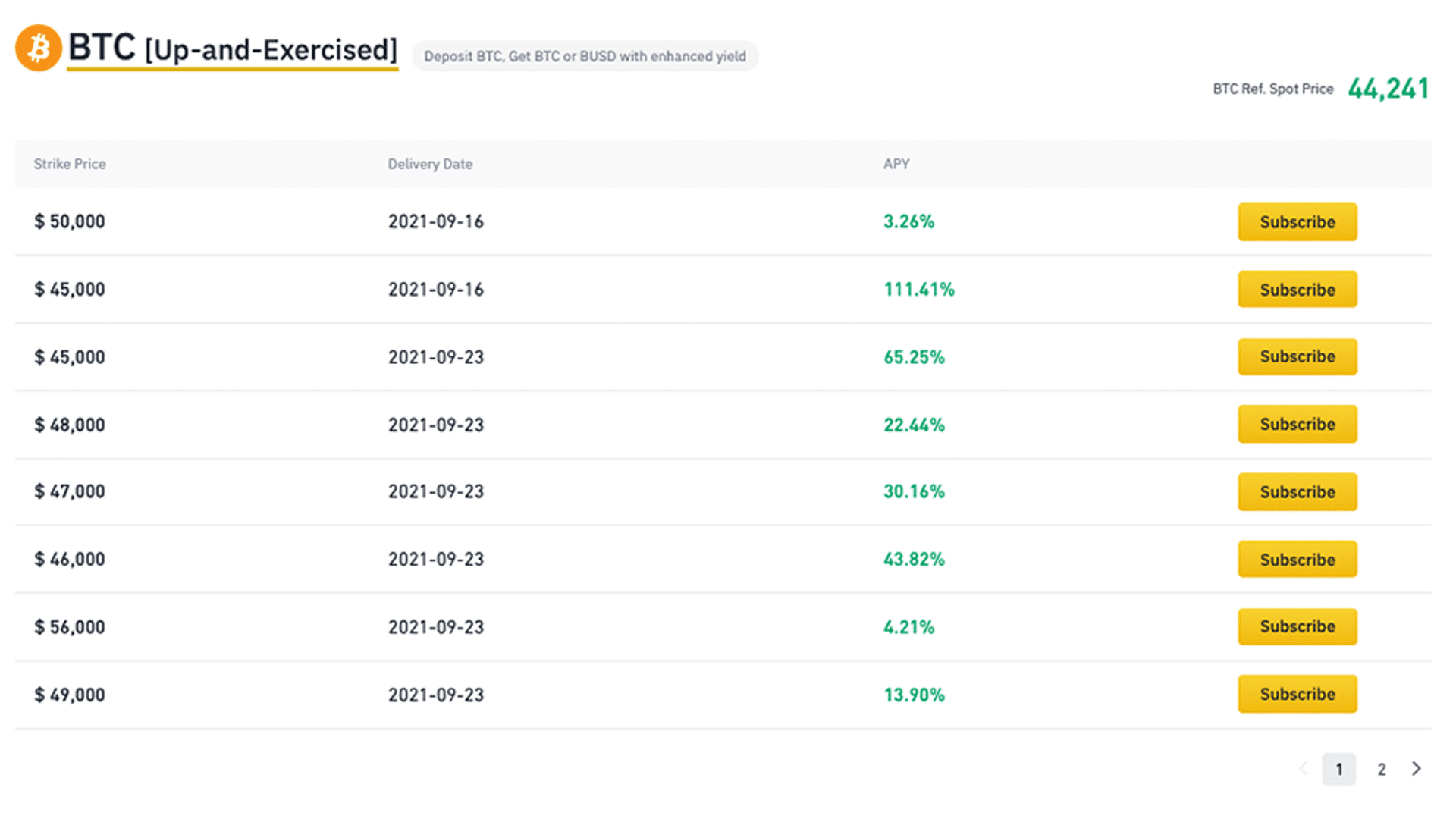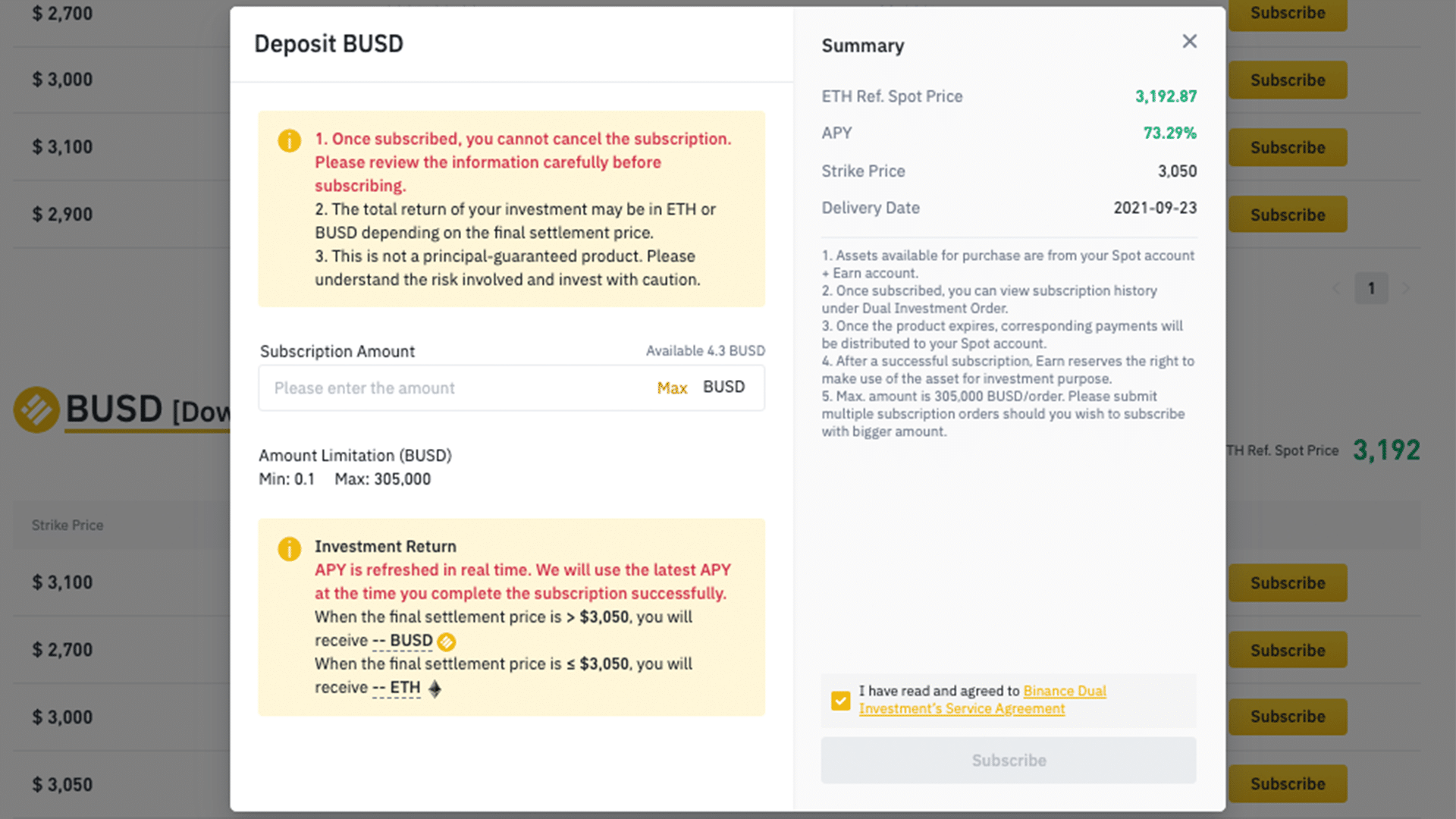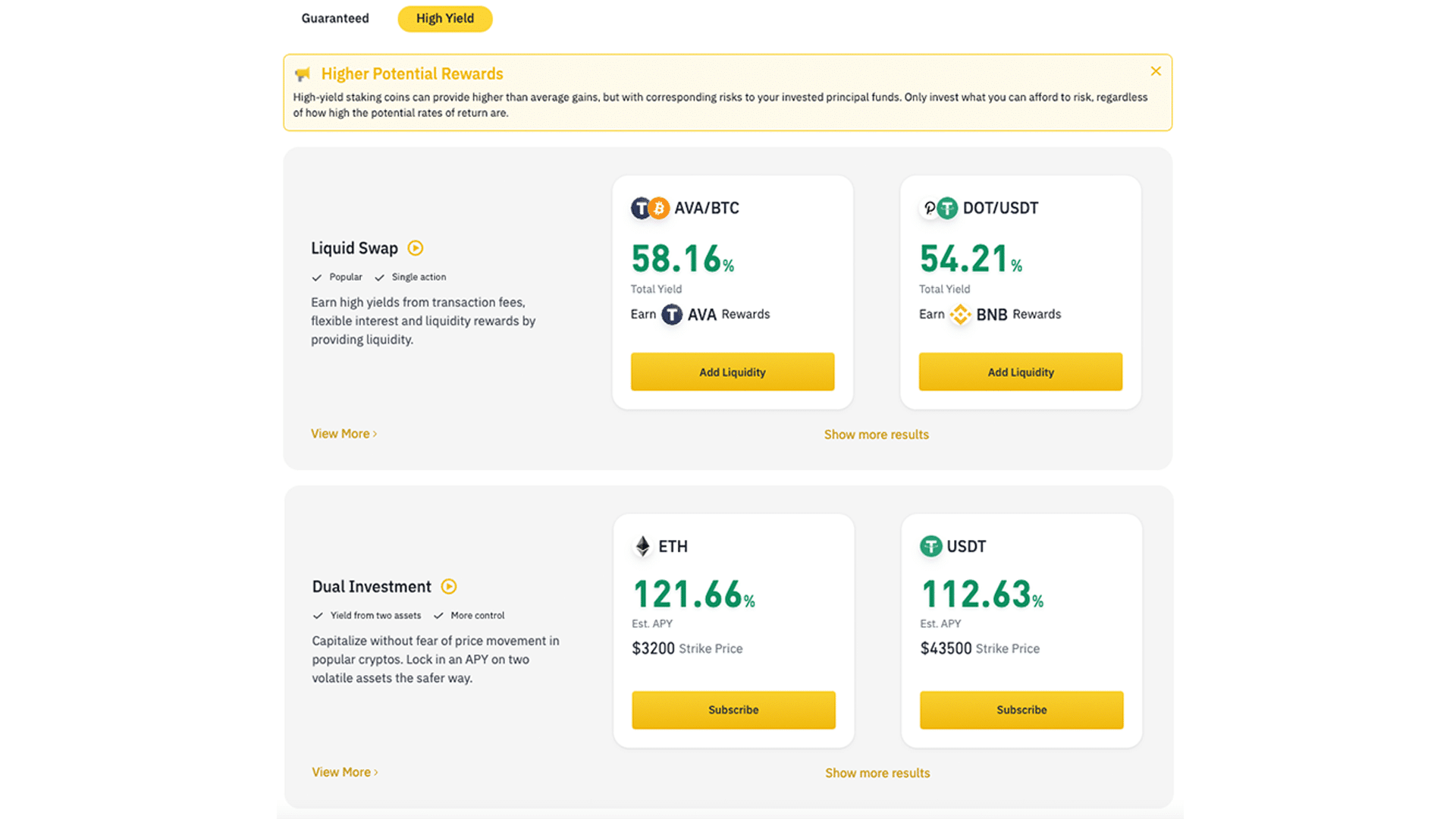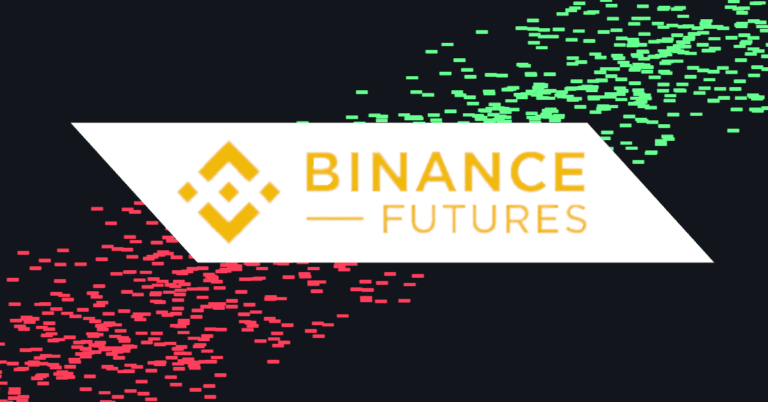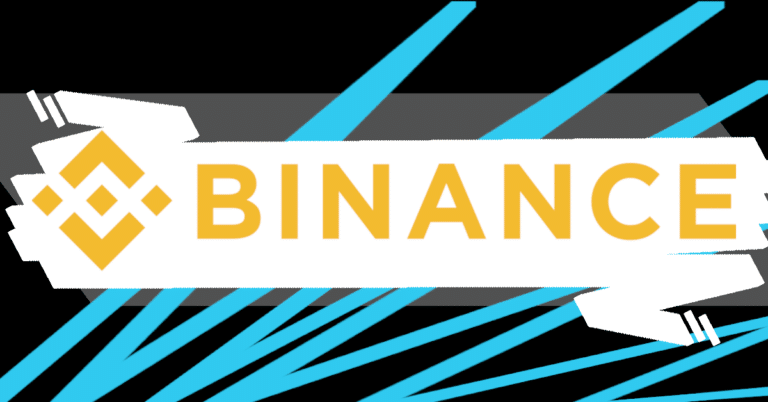*This post may contain affiliate links that help keep the lights on, find more info in our full disclaimer.
+100% APY Options Yield (Top-Rated) Binance Dual Investment 2023
- Thomas DeMichele
Binance Dual Investment Explained
Binance Dual investment is a Binance Earn product that lets you access some of the highest cryptocurrency yields on Binance.
This is done by speculating or hedging on the direction of the market, similarly to writing options. To do this, you can use the following cryptocurrency assets to subscribe to a Dual Investment product with a specific strike price and delivery date:
- USDT
- BUSD
- ETH
- BTC
If the settlement price of the underlying asset exceeds the strike price on the delivery date, the contract is exercised.
All italicized words are defined in the terminology section later in the article. If you are unsure what one of them means, scroll down to find out!
If the product is exercised, you get the alternate asset of the product, for example, BUSD in the BTC [Up-and-Exercised] product featured in the image below.
If it isn’t exercised, you keep your original deposit currency, for example, BTC in the image below (although regardless of the outcome, you earn a yield paid in the asset you receive). In other words, you always get an APY from your investment but will receive only one of two assets at the delivery date. In fact, this is where Binance’s “Dual Investment” product gets its name.
The following article will walk you through everything you need to know to lock in yields of over 100% using Dual Investment products. We will also cover how Dual Investment compares to Binance Vanilla options, other crypto options, and Binance Earn products.
Binance Dual Investment Special Promotion
Not only can you earn some of the best APYs for single assets in crypto with Binance Dual Investment, but you can also often earn extra bonuses.
This section will list the most recent limited-time promotions and deals to help you boost your Dual Investment earnings. Make sure to bookmark this page and keep your eye out for more deals to come.
Most recent Binance Dual Investment offer:
Want to share in $10,000 a Prize Pool just for investing in a Binance Dual Investment product? For a limited time, all new Dual Investment users will share in an exclusive $10,000 BNB rewards pool that will be split evenly between everyone who invests.
To qualify, you must subscribe to a dual investment product with at least 0.002 BTC, 0.03 ETH, 100 USDT, or 100 BUSD by 2021-09-23 00:00 (UTC).
Using Binance Dual Investment & Binance Options Together?
In the article’s introduction, we mentioned Binance Dual Investment is similar to writing options. There are, however some important differences to discuss. One of the main differences between writing a cryptocurrency option and subscribing to a Dual Investment product is that you get yield at the delivery date with Dual Investment instead of a premium upfront when you sell the contract like you would with traditional options.
Another key difference is that you can essentially buy yourself out of an options contract you write before the expiration date, while you are locked into a Dual Investment agreement for its duration.
Lastly, another notable difference is that you can’t take every trade with Dual Investment you can with options. With Dual Investment, you can only effectively sell higher than the current price or buy lower than the current price. While writing traditional calls and puts offers this same binary choice, writing uncovered calls and puts and buying and selling options already on the market allows for a wider variety of trades.
Despite some important differences between options and Dual Investment, Binance Dual Investment products pair well with Binance options. This is especially true since Binance is the sole-issuer of their options, meaning they write all contracts and users can only buy and sell those contracts (users can’t write them).
Therefore, in many ways, Dual Investment becomes an instrument with which you can essentially write options on Binance.
How to Sign Up For Binance Dual Investment
To get started with Dual Investment products, you’ll need a Binance account. So if you don’t have one already, use our Binance referral code SRC2N1F2 to get a 20% discount on trading fees for life (see our Binance Referral Code Review for more on how to save on Binance).
Next, log into your Binance account and then click these buttons in this order “Finance” -> “Binance Earn” -> “High Yield“. There you will see BTC, ETH, USDT, and BUSD product options with different interest rates (APYs), settlement prices, strike prices, and delivery dates.
Pick the product that makes the most sense for your needs and hit the “subscribe” button to see the final confirmation screen (or, if this is your first time, you’ll take a test first; See below for more information on the Binance Dual Investment test).
Once you verify the terms of the product, set the subscription amount, and click the button to verify you have read the service agreement, you can then hit the “subscribe” button to enter that product for its duration.
However, keep in mind that you lock in both the APY and the underlying asset for the duration of the contract once you subscribe. There is no way to exit the agreement before the delivery date!
Why Use Binance Dual Investment?
Binance Dual Investment products allow you to earn a passive income without dealing with the more complicated aspects of options like the Greeks. Writing crypto options is great for hedging or generating a passive income from your cryptocurrency holdings, especially when you choose a strike price you would buy or sell your cryptocurrency holdings at anyway.
The logic is the same with Dual Investment. You can earn a yield from BTC, ETH, and stable coins by choosing prices you are willing to buy or sell crypto assets at within a given timeframe.
Remember, there is no way to exit a contract until the delivery date of said agreement, so plan accordingly.
Example 1:
Bitcoin is currently $30k. You plan on selling your Bitcoin if it goes above $38k before the end of the month, so you subscribe to an Up-and-Exercised Dual Investment product with a strike price of $38k and a delivery date of the 30th (the closest product you could find to the end of the month).
If the target is exceeded on the delivery date, you will be paid BUSD plus interest (BUSD is Binance’s stable coin, which is pegged to the US dollar). If the target isn’t hit, you keep your Bitcoin and get paid the interest in BTC.

Example 2:
Say you are in stables, and you plan to buy Ethereum or Bitcoin below a certain price. You can instead use a USDT or BUSD Down-and-Exercised product.
This would result in you having BTC or ETH, respectively, if the settlement price is below the strike price by the delivery date.
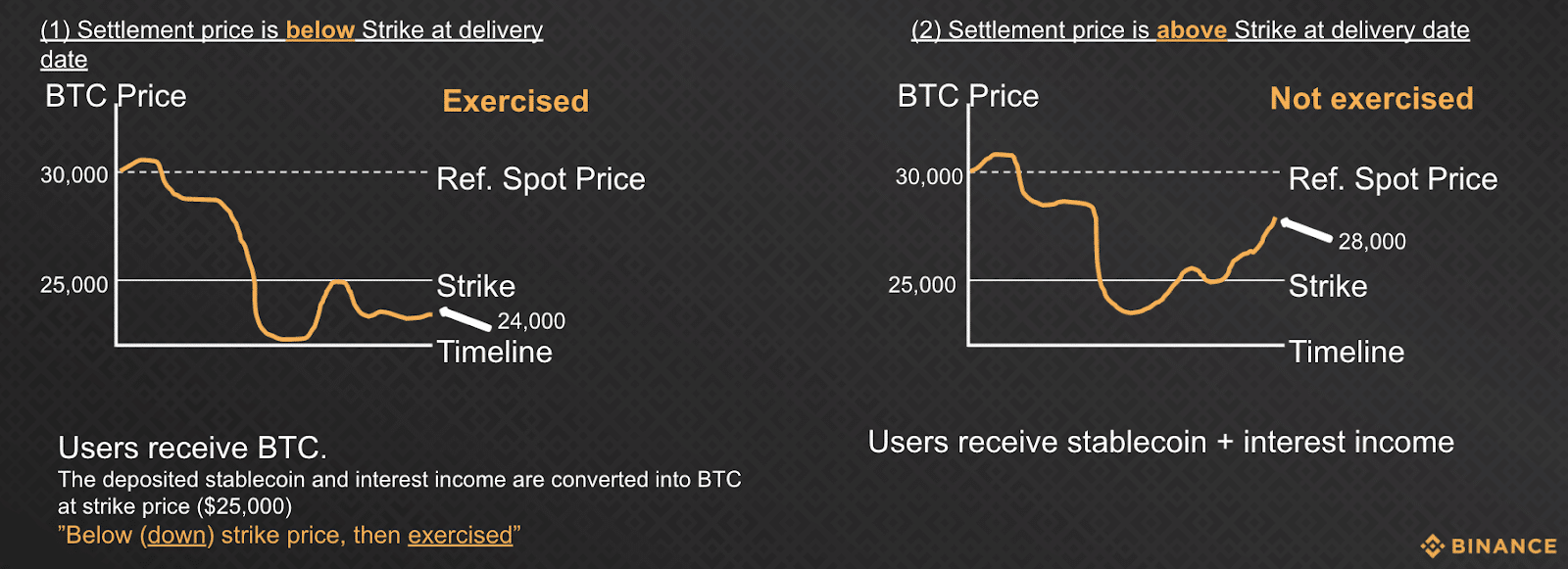
No matter what the outcome is, you are creating a passive income source. The outcome of the product on the delivery date only impacts which asset you get and at what price you buy or sell (in the case that the settlement price exceeded the strike price on the delivery date).
That makes these Dual Investment products great for someone who is, for example, sitting partly in Bitcoin and partly in stables and wants to generate a passive income through interest. Or for someone who plans to buy/sell their crypto holdings at a certain price anyway.
Dual Investment Products Have High Yields
As noted in the introduction, Dual Investment products can pay over 100% APY at times on relatively safe assets like BTC, ETH, and stable coins. The only other Binance product that comes close to this is Liquid Swaps, and for that product, you have risks like impermanent loss and are forced to hold crypto assets which tend to be more volatile.
Meanwhile, other single-asset Earn options for BTC, ETH, and stables typically pay single-digit APYs. So truly, nothing else comes close to the interest you can earn with Dual Investment.
Of course, you do have to take on associated risks into account for this impressive return rate, but we feel it will likely fit within most user’s risk tolerance limits.
Binance Dual Investment Risks
Technically speaking, Binance Dual Investment products are High risk, high return non-principal protected products where users may receive different currencies according to the settlement price. So one type of risk is that your deposit currency will be converted into the alternate currency upon the product being exercised when in retrospect you would prefer it not to be. Meanwhile, another important risk to consider is that you can’t access your funds for the duration of the agreement after you subscribe.
In that sense, the main risks you face with Dual Investment Products are risks of not being able to sell at more favorable prices than a product’s strike price due to being locked into an agreement.
For example, if you enter an Up-And-Exercised product with a strike price of $50k, but on the delivery date, Bitcoin is $60k, you would experience an upside loss of $10k minus the interest paid. While you still made money, you would have made more money had you sold Bitcoin at $60k instead of being locked into the agreement.
Of course, this isn’t the only risk. Consider instead that you enter an Up-And-Exercised product with a strike price of $50k, but on the delivery date, Bitcoin is $30k. You missed the chance to sell higher, and there is no way to buy yourself out of the agreement! In this sense, dual investment products open you up to a potential loss.
Dual Investment products are like writing options to earn extra income in this sense as well, as they are often at their most attractive when the settlement price does not exceed the strike price on the delivery date. However, unlike options, you cannot buy yourself out of your agreement, and in this sense, they have some additional risk associated with them.
With that in mind, a more conservative investor might target lower APY options that have strike prices that are far out of the money to reduce the risks of the strike price being exceeded or may choose to focus on contracts with fewer deposit days to avoid potential volatility over time.
Understanding Dual Investment Products
The most important things to understand about Dual Investment Products terms we have used within this article and are used on the platform, such as subscribing, strike price, settlement price, delivery date, underlying asset, deposit currency, and alternate asset. Also significant are the difference between Up-and-Exercised and Down-and-Exercised products.
So let’s cover these and others in detail more thoroughly now below.
Dual Investment Terminology
In this section we will explain Dual Investment terminology, then below we will offer plain defitions to help you fully understand how everything works.
Entering into a Dual Investment product for the duration of an agreement is called subscribing. You’ll see a “subscribe” button next to each strike and delivery date pairing.
Once you subscribe, the deposit currency will be locked in until the delivery date for the amount you subscribed for. Keep in mind there is no way to exit the contract once you subscribe to it. The settlement price is always the reference spot price at 08:00 (UTC) on the delivery date. Thus the delivery date is always 08:00 (UTC) on the date noted on the product.
Meanwhile, strike price is the price an asset must be above (Up-and-Exercised) or below (Down-and-Exercised) for the terms of a product’s agreement to trigger.
If the settlement price is above the strike price on a Up-and-Exercised product on the delivery date, then the product’s terms are executed (AKA exercised). Then you will be paid in the alternate currency of the contract plus interest (for example, BUSD with the BTC Up-and-Exercised product plus interest paid in BUSD). If the terms of the contract are not met, that you will keep the underlying asset and be paid interest.
One last thing, each product type has an underlying asset on which the strike prices are based. That asset will be in the name of the product, so for example, the underlying asset of the BTC (Up-and-Exercised) product is BTC.
The “up-and-exercised” and “down-in-exercised” section below will offer more examples. For more on how Dual Investment products work, see Binance’s What is Binance Dual Investment page. That page includes step-by-step directions for subscribing and a helpful video.
Binance Dual Investment & Options Glossary
Here are definitions for many of the terms used above and some of the other Binance Dual Investment and Options terms used on this page.
- Alternate Currency
- – The asset you get if a Dual Investment product is exercised.
- Annual Percentage Yield (APY)
- – The amount of interest you would earn if the product was held for one year.
- Delivery Date
- – The date on which the agreement is exercised and your asset plus interest can be redeemed.
- Deposit Currency
- – The asset you deposit in a Dual Investment product.
- Deposit Days
- – The number of days left until the delivery date.
- Down-and-Exercised
- – A Dual Investment product where contracts are exercised if the settlement is below the strike price. You deposit USDT or BUSD, and BTC or ETH is the alternate asset.
- Exercised
- – When an agreements terms are carried out. With Dual Investment products, it is when a contract pays out in the alternate asset on the delivery date.
- Far Out Of The Money
- – An options term that means the spot price of the asset has not yet exceeded the strike price. Far out of the money means the spot price is far from exceeding the strike price.
- High Risk, High Return
- – Typically risker investments offer a higher return.
- Near The Money
- – An options term that means the spot price of the asset is near the strike price.
- Reference Spot Price
- – The current market price of the underlying asset being tracked.
- Settlement Price
- – The spot price of the underlying asset at 08:00 (UTC) on the expiry date.
- Single-asset
- – You typically will have to put up one or more assets with cryptocurrency yields. Multi-asset means more than one asset. Single-asset means only one asset.
- Strike Price
- – The price which must be exceeded for a product to be exercised.
- Subscribe
- – When you enter into a Dual Investment product for its duration.
- The Greeks
- – A term to describe risk factors that impact the price of options such as Implied Volatility.
- Underlying Asset
- – The asset a Dual Investment product is tracking the spot price of.
- Upside Loss
- – Money you could have made. In this case, the money you could have made if you weren’t locked in a Dual Investment agreement.
- Up-and-Exercised
- – A Dual Investment product where contracts are exercised if the settlement is above the strike price. You deposit BTC or ETH, and USDT or BUSD is the alternate asset.
Up-and-Exercised Vs Down-and-Exercised
There are two types of Dual Investment products, “[Up-and-Exercised]” and “[Down-and-Exercised]”.
Up-and-Exercised products:
If the Settlement Price is above the Strike Price, the product is “exercised“. In other words, if it is “up“. it is “exercised“.
Down-and-Exercised products:
If the Settlement Price is below the Strike Price, the product is “exercised“. In other words, if it is “down“, it is “exercised“.
Remember, you get paid interest regardless of the outcome upon the contract’s expiration (although you have to wait up to 48 hours for the funds to show in your wallet). The outcome only determines what type of crypto asset your interest is paid in, as you’ll always be paid in the asset the product resulted in when exercised.
Lock in Your APY Based on Volatility, Price, and Time
Annual Percentage Yield (APY) is the percentage of interest you would earn in one year at a specific rate. One good thing is that your Binance Dual Investment is that your APY is locked in when you subscribe (despite the APY constantly changing before you lock it in).
So if you find an attractive APY, you can get it guaranteed for the duration of the agreement at that point. Since APY is based on factors like price, remaining days, and volatility, you can lock in some pretty high APYs by looking for opportunities and tactically entering contracts based on those factors.
You can be paid in one of two assets (either the deposit currency or the alternate asset), and that is where “Dual Investment” gets its name!
Binance Dual Investment Quiz
When you first attempt to subscribe to Binance Dual Investment, you’ll have to take a test. This test will have a series of questions with multiple choice answers.
This article has all the information you need to ace that quiz, so feel free to reference it when you take the test.
Despite preparing for the test, you might still get stuck on the questions about which currency you will receive or how much you will receive at the end of a product’s delivery date.
The trick to getting these questions right is understanding that the product type is implied by the underlying asset and the asset listed under the subscription amount.
| Q1 | You subscribed to a Dual Investment product with the below information
Underlying Asset – BTC At the delivery date, the settlement price is $21,000. Which currency will you receive in the end? |
| Answer | BUSD |
| Logic | The fact you are subscribing with BTC to a product that uses BTC as the underlying asset implies that you are entering the BTC [Up-and-Exercised] product. This is because BTC [Up-and-Exercised] is the only product in which you can deposit BTC. With this product, you can get either the deposit currency BTC or the alternate currency BUSD upon the delivery date.
Since the settlement price is above the strike price in the example, and since we know it is “up-and-exercised”, that means we know the contract in the example was exercised. Thus we are getting the alternate currency of BUSD upon the delivery date! |
| Q2 | You subscribed to a Dual Investment product with the below information
Underlying Asset – BTC At the delivery date, the settlement price is $40,000. How much will you receive in the end? |
| Answer | 0.1 BTC + interest |
| Logic | This is because only the BUSD [Down-and-Exercised] product allows us to deposit BUSD and get BTC or BUSD with an enhanced yield. Thus if our settlement price is below our strike price, this must be a contract being exercised, and thus we would get the alternate currency BTC plus interest (not our original BUSD deposit plus interest). |
As you can see, you really have to take the time to understand each product offered, and the logic behind them before you can pass this quiz and use Binance Dual Investment products!
Dual Investment Vs Traditional Options
As we mentioned previously in this article, Dual Investment products work similarly to writing options (something you can’t do on Binance’s options platform).
With regular options, your contract is with another market participant, and you get paid a premium upfront in return for selling a contract. Then if the market price of the asset exceeds your strike price on the expiration date of the contract, you have to sell the underlying asset at the agreed-upon “strike” price.
With Binance Dual Investment, your agreement is with Binance, and you get a yield on the amount regardless of the outcome. Otherwise, like with regular options, if the asset’s market price exceeds the strike price, you have to settle the underlying funds at the strike price.
Dual Investment Products eliminate some risks of options, but in return, they can, in theory, payout less than traditional options depending on the market and your skill as an options trader. This is because Binance determines the current APY of a contract based on factors like strike price, remaining days until the delivery date, and price volatility. Whereas with options, market participants determine what they will buy and sell for (albeit based on similar metrics).
Likewise, as noted above, Dual Investment is also more limited, as you can’t buy yourself out of a contract or mimic every type of trade options markets allow for.
Thus, a skilled options trader will likely check out both options and Dual Investment and pick the one that offers the best return and suits their needs.
However, a more casual user will likely find Dual Investment’s simplicity an attractive alternate to writing options, especially since they will know the APY being offered is always fairly priced based on Binance’s models.
Binance Options, Dual investment, or Other Earn Products?
Dual investment and Binance Options work well together, and typically you won’t choose one or the other. You will likely instead use both. You would use Binance options for options trading and Dual Investment for most of your options writing needs.
Likewise, Dual Investment and other Binance Earn products aren’t an either-or choice. For example, there may be times when Dual Investment is offering an attractive APY for a strike price and delivery date you have confidence in, but outside those times, you may choose to get your yield from other Earn products.
Just like you wouldn’t always necessarily hedge by writing options, you might not always choose Dual Investment for your yields. With that said, some people may choose to focus their whole trading strategy around hedging or even speculating with Dual Investment products due to the often outstanding APYs.
Given the above, Binance Dual Investment isn’t just a simpler way to fulfill your options writing needs or a better way to Earn yields. It is the only way to write options and a vital part of any yield seeker’s toolkit.

